Common Exponents
It may be worth your while to memorize a few common exponents before the test.
Knowing these regularly used exponents can save you the time it would take to
calculate them during the test. Here is a list of squares from 1 through 10:

emorizing the first few cubes can be helpful as well:

Finally, the first few powers of two are useful for many applications:

Adding and Subtracting Numbers with Exponents
In order to add or subtract numbers with exponents, you have to first find the
value of each power, and then add the two numbers. For example, to add 33
+ 42, you must expand the exponents to get (3× 3 × 3) + (4 × 4), and then, finally, 27 + 16 = 43.
If you’re dealing with algebraic expressions that have the same bases and
exponents, such as 3x4 and 5x4, then they
can simply be added and subtracted. For example, 3x4 + 5x4
= 8x4.
Multiplying and Dividing Numbers with Exponents
To multiply exponential numbers or terms that have the same base, add the
exponents together:
3
6 × 3
2 = 3
(6 + 2) = 3
8
x 4 ×
x 3 =
x (4 + 3 )=
x 7
To divide two same-base exponential numbers or terms, just subtract the
exponents.

To multiply exponential numbers raised to the same exponent, raise their product
to that exponent:
4
3 × 5
3 = ( 4 × 5
3 = 20
3
a
5 × b
5 = ( a × b)
5=ab
5
To divide exponential numbers raised to the same exponent, raise their quotient
to that exponent:

If you need to multiply or divide two exponential numbers that do not have the
same base or exponent, you’ll just have to do your work the old-fashioned way:
multiply the exponential numbers out and multiply or divide the result
accordingly.
Raising an Exponent to an Exponent
Occasionally you might encounter an exponent raised to another exponent, as seen
in the following formats (32)4 and (x4)3.
In such cases, multiply the powers:
(32)4 = (3)2 × 4 = 3 8
(x4)3 = (x)4 × 3 = x 12
Exponents and Fractions
To raise a fraction to an exponent, raise both the numerator and denominator to
that exponent:
3=127.gif)
Exponents and Negative Numbers
As we said in the section on negative numbers, when you multiply a negative
number by another negative number, you get a positive number, and when you
multiply a negative number by a positive number, you get a negative number.
These rules affect how negative numbers function in reference to exponents.
- When you raise a negative number to an even-number exponent, you get a positive
number. For example (–2)4 = 16. To see why this is so, let’s break
down the example. (–2)4 means –2 × –2 × –2 ×–2. When you multiply the first two –2s together, you get +4 because you are
multiplying two negative numbers. Then, when you multiply the +4 by the next –2,
you get –8, since you are multiplying a positive number by a negative number.
Finally, you multiply the –8 by the last –2 and get +16, since you’re once again
multiplying two negative numbers.
- When you raise a negative number to an odd power, you get a negative number. To
see why, all you have to do is look at the example above and stop the process at
–8, which equals (–2)3.
These rules can help a great deal as you go about eliminating answer choices and
checking potentially correct answers. For example, if you have a negative number
raised to an odd power, and you get a positive answer, you know your answer is
wrong. Likewise, on that same question, you could eliminate any answer choices
that are positive.
Special Exponents
There are a few special properties of certain exponents that you also need to
know.
Zero
Any base raised to the power of zero is equal to 1. If you see any exponent of
the form x0, you should know that its value is 1. Note,
however, that 00 is undefinded.
One
Any base raised to the power of one is equal to itself. For example, 21
= 2, (–67)1 = –67 and x1 = x. This can be
helpful when you’re attempting an operation on exponential terms with the same
base. For example:
3x6 × x = 3x6 × x1 = 3 =3x(6 + 1) = 3x 7
Fractional Exponents
Exponents can be fractions, too. When a number or term is raised to a fractional
power, it is called taking the root of that number or term. This
expression can be converted into a more convenient form:
xa/b =
6 v
xa
Or, for example, 213 / 5 is equal to the fifth root of 2 to the
thirteenth power:
6 v213 = 6.063
The v symbol is also known as the radical, and anything under the radical, in
this case 2 13 ,is called the radicand. For a more familiar example, look at 91/2,
which is the same as v9
2 v91 = v9 = 3
Fractional exponents will play a large role on SAT II Math IC, so we are just
giving you a quick introduction to the topic now. Don’t worry if some of this
doesn’t quite make sense now; we’ll go over roots thoroughly in the next
section.
Negative Exponents
Seeing a negative number as a power may be a little strange the first time
around. But the principle at work is simple. Any number or term raised to a
negative power is equal to the reciprocal of that base raised to the opposite
power. For example:

Or, a slightly more complicated example:

With that, you’ve got the four rules of special exponents. Here are some
examples to firm up your knowledge:


Next to display next topic in the chapter.
Mathematics Practice Questions
Video Lessons and 10 Fully Explained Grand Tests
Large number of solved practice MCQ with explanations. Video Lessons and 10 Fully explained Grand/Full Tests.